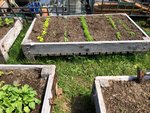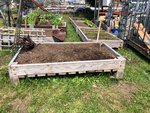

I don’t know about you but after the recent rain and snowstorms, I am ready for spring. Now I know it won’t arrive for a while but that doesn’t stop me from dreaming about it – or planning for it.
Like most people my age I enjoy gardening. Any excuse to get outdoors in this magnificent wonderland we live in brings me a sense of pure joy. However, I am no longer a spring chicken, and gardens have to be planted, cared for and, in some instances, harvested.
Not one to give up easily, I have come up with some plans to work around rickety knees and touchy backs. Actually, we have several options for gardening and having tried most of them, I am happy to share the results.
I love container gardening and am fortunate enough to have had some built for me. I am not speaking of the low to the ground ones, but containers about waist-high or chest-high.
Since most, but not all, of them have to be built, your specifications may vary depending on your height, mobility level and what you want to plant. But these types of containers can work for those using canes, wheelchairs or those without any mobility issues. And they can be as deep and wide as you wish.
Some plants require room for deep roots. Others, like mint or rosemary, can take over the surrounding areas, crowding out smaller herbs. Clearly, we need to have a plan.
The final step is to build or buy your container(s).
Raised beds are generally three to four-and-a-half feet high, three to four feet wide and as long as desired. However, depending on the individual's strength and endurance, it would be wise to limit the length of the bed to 10 or 20 feet to prevent over-exertion in circling the bed.
If building is not an option, especially for those living in apartments or retirement communities, pots of all sizes are available along with window boxes that can placed on the patio or attached to a railing if you have one.
Another option, and one of my personal favorites, is the pallet.
Pallets are our friends. They can be used upright, horizontally or stacked on top of each other – embedded in the ground, attached to or leaned against something. They can be decorated, painted, stained or left in their natural state. All you have to add is a liner, dirt and your plant.
And here is another thought. If you happen to live in a retirement or assisted living community (or even in your own home) and you have some open space and can get permission to use it, containers can be built by volunteers and used by one and all.
Boy Scouts, service clubs like the Rotary, Kiwanis, Lions and others are often looking for projects to help the communities they serve. They usually all have websites with contact information. Ask them to consider your request.
If this pandemic has taught us nothing else it is that we all need to offer a helping hand to each other. Growing some of our own food can help alleviate food shortages seniors often face and eliminate issues they may have getting to the store.
As simple as it may sound, gardening provides food, flowers, fresh air, exercise and a sense of accomplishment – things we all need to thrive.
NOTE: Midway Recycling, 7834 Old Hwy 99 SE, Tumwater, is re-purposing more than 100 raised garden bed frames. Previously used at the Ostrom mushroom farm in Lacey, these sturdy wooden boxes range in price from $25 to as much as $100, including delivery, depending on delivery location. Info: call 360-819-4996.
Kathleen Anderson writes this column each week. Contact her at kathleen@theJOLTnews.com or post your comment below.
Comments
No comments on this item Please log in to comment by clicking here